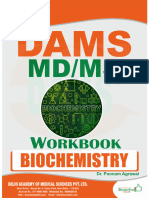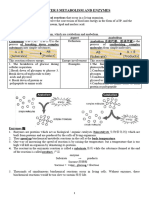Biochemestry 3 Assignment
Uploaded by
keithotieno5Biochemestry 3 Assignment
Uploaded by
keithotieno5BIOCHEMESTRY 3 ASSIGNMENT
DUKE RACHAMI
HSP201-0015/2023
Lecturer; Dr Gervason moriasi
1 Discuss. In details the different types of inhibition in enzymes
A Competitive inhibition
It is also known as reversible Inhibition. In this type of inhibition the enzyme-inhibitor complexes are
formed during the reaction, however it depends on
time of reintubation of enzyme with the substrate
affinity between enzyme and substrate
When the concentrated substrate is increased the effect of inhibitor can be reversed forcing out of from
EL complex
Example Allopurinol: a drug used for treatment of gout.
B NON-competitive inhibition-there are two different types,
Reversible
Irreversible
The inhibitor may combine with both free enzyme and ES complex which would probably change the 3D
structure of the enzyme inactivating it catalytically .In non-competitive inhibition Vmax is lowered but
Km is kept constant .If the inhibitor can be removed from its site of binding without affecting the activity
of the enzyme is called Reversible noncompetitive inhibition. If the inhibitor is removed and causes
enzymatic reaction it is called irreversible non –competitive inhibition
Example Fluoride: inhibits the enzyme enolase by removing magnesium ions and manganese ions which
stops glycolysis
C Allosteric Inhibition
There is a mixed kind of inhibition when the inhibitor binds to the enzyme –substrate complex forming
an inhibitor enzyme substrate complex. This type of inhibition is unique because it requires the
substrate to be bound to the enzyme before the inhibitor can bind .it results in a decrease in the
maximum velocity of the binding of the substrate to the enzyme.
D Suicide Inhibition
Is a special type of inhibition where the substrate analogue is converted to a more effective inhibitor
with the enzyme to be inhibited? The so formed substrate new inhibitor binds irreversibly with the
enzyme.
ExampleAsprin: a: a: a drug used for relieving pain.
E uncompetitive inhibition
Occurs when the inhibitors binds only to the enzyme –substrate complex forming an inhibitor enzyme
substrate complex. This type of inhibition is unique because it requires the substrate to be bound to the
enzyme before the inhibitor can bind. It results in a decrease in decrease in the maximum velocity of the
reaction and does not affect the binding of the substrate to the enzyme.
2 Discuss in details the mechanisms through which enzymes are
regulated (providing real life examples)
Ubiquitin –proteasome pathway is one the mechanism through which enzymes are regulated.
Thus the ubiquitin-proteasome pathway can selectively degrade proteins whose physical integrity and
fictional competency has compromised:
By the loss of or damage to a prosthetic group.
Oxidation of cysteine or histidine residues.
Deamination of asparagine’s or glutamine residues.
Recognition by proteolytic enzymes also can be regulated by covalent modification such as
phosphorylation binding of substrates or allosteric effectors or association with membranes
oligonucleotides or other proteins.
Example: streptokinase and urokinase: it: it increases the conversion of plasminogen to plasmin which
later breakdown fibrin to attain thrombolysis.
3 Discuss in details the role of enzymes in pharmacology
Systemically used enzymes include:
Streptokinase
It is used to increase the circulating level of plasminogen
An indicator is acute myocardial infarction.
L-asparagine
Certain tumors cells require it for growth .L-asparagine also enables hydrolases.
Some of its indicators include acute leukemia and malignant lymphomas.
Amylase, Lipase and protease
Replacement therapy in pancreatic insufficiency some of its indicators include
Cystic fibrosis
Chronic pancreatitis
Serratopeptidase
Exhbits its fibrinolytic activity high bradykinin decomposing activity and potent casein lytic
activity.
An indicator is subconjuctal bleeding.
Enzymes used in the laboratory as reagent
Glucose oxidase- used for estimation of true glucose in blood and body fluids.
Enzyme Uri case- used in estimation of serum uric acid
Enzyme urease- used for estimation of urea in blood and body fluids
Enzymes used locally
Hyaluroniclase- it brings about depolymerisation of ground substance and helps in absorption of
fluids.
An indicator is that it promotes diffusion of fluids.
You might also like
- Lab 1.1 Protocol - Easy Lithium Acetate Transformation of Yeast - UPDATEDNo ratings yetLab 1.1 Protocol - Easy Lithium Acetate Transformation of Yeast - UPDATED10 pages
- 11- Enzyme Inhibition and Related Mechanisms (1)No ratings yet11- Enzyme Inhibition and Related Mechanisms (1)30 pages
- Chapter 4 B Inhibition of Enzyme Activity 3rd Year Chemistry Dep'tNo ratings yetChapter 4 B Inhibition of Enzyme Activity 3rd Year Chemistry Dep't21 pages
- 187 - Biochemistry Physiology) Enzyme InhibitionNo ratings yet187 - Biochemistry Physiology) Enzyme Inhibition7 pages
- Biochemistry Enzyme Inhibition Arellano BSMTNo ratings yetBiochemistry Enzyme Inhibition Arellano BSMT6 pages
- Enzyme(Inhibition Cofactors and Coenzymes)No ratings yetEnzyme(Inhibition Cofactors and Coenzymes)52 pages
- Enzyme Regulation^LJ Inhibitors and Clinical Applications _Nov 2024No ratings yetEnzyme Regulation^LJ Inhibitors and Clinical Applications _Nov 202417 pages
- 4. Enzymes_inhibitionF _MS_ 14 Mar 2023No ratings yet4. Enzymes_inhibitionF _MS_ 14 Mar 202333 pages
- Biochemistry-Clinical-Pathology-CH-6-Enzymes-NotesNo ratings yetBiochemistry-Clinical-Pathology-CH-6-Enzymes-Notes6 pages
- Biochemistry 1 Lesson 22 (Enzyme Inhibitors)No ratings yetBiochemistry 1 Lesson 22 (Enzyme Inhibitors)43 pages
- Enzyme Inhibition (Reversible and Irreversible) and Its ApplicationNo ratings yetEnzyme Inhibition (Reversible and Irreversible) and Its Application40 pages
- All of Those Enzymes Up and Metabolize As Fast As Possible! As It TurnsNo ratings yetAll of Those Enzymes Up and Metabolize As Fast As Possible! As It Turns11 pages
- B.sc. Nursing Enzyme Inhibition & Co-EnzymesNo ratings yetB.sc. Nursing Enzyme Inhibition & Co-Enzymes20 pages
- MLAB 2401: Clinical Chemistry Keri Brophy-Martinez: Enzymes: OverviewNo ratings yetMLAB 2401: Clinical Chemistry Keri Brophy-Martinez: Enzymes: Overview30 pages
- Structure-Function Studies of DNA Polymerase LambdaNo ratings yetStructure-Function Studies of DNA Polymerase Lambda10 pages
- Mark Scheme (Results) Summer 2013 GCE Biology (6BI04) Paper 01 Unit 4: The Natural Environment and Species SurvivalNo ratings yetMark Scheme (Results) Summer 2013 GCE Biology (6BI04) Paper 01 Unit 4: The Natural Environment and Species Survival22 pages
- Performance Assessment - Sickle-Cell Trait InfographicNo ratings yetPerformance Assessment - Sickle-Cell Trait Infographic2 pages
- Biology Midterm Exam Review Guide - The TOP 100 Questions Scientific Inquiry and Biological Principles (Chapter 1)No ratings yetBiology Midterm Exam Review Guide - The TOP 100 Questions Scientific Inquiry and Biological Principles (Chapter 1)4 pages
- Transport Across Natural and Modified Biological Membranes and Its Implications in Physiology and Therapy 1st Edition Julita Kulbacka100% (4)Transport Across Natural and Modified Biological Membranes and Its Implications in Physiology and Therapy 1st Edition Julita Kulbacka62 pages
- Cellular Transport Test - K-R - 13-14 - KEYNo ratings yetCellular Transport Test - K-R - 13-14 - KEY9 pages
- The Diagram Shows The Tertiary Structure of A Molecule of The Enzyme RnaseNo ratings yetThe Diagram Shows The Tertiary Structure of A Molecule of The Enzyme Rnase9 pages
- Antigen - Antibody Interaction: By: Dr. Luna PhukanNo ratings yetAntigen - Antibody Interaction: By: Dr. Luna Phukan13 pages
- Proteomics in Nephrology. Towards Clinical Applications (2008)No ratings yetProteomics in Nephrology. Towards Clinical Applications (2008)213 pages
- Methods of Dna Extraction Presented By: Ayesha Kabeer: University of Gujrat Sialkot SubcampusNo ratings yetMethods of Dna Extraction Presented By: Ayesha Kabeer: University of Gujrat Sialkot Subcampus24 pages
- Chem 4B Midterm 3 Spring 2012 SolutionsNo ratings yetChem 4B Midterm 3 Spring 2012 Solutions11 pages
- Scientific Research Journal of India SRJI ScReJi Complete Vol-6 2022 All IssuesNo ratings yetScientific Research Journal of India SRJI ScReJi Complete Vol-6 2022 All Issues92 pages
- Science 10 Summative Test 2 Quarter 3 With Answer Key100% (4)Science 10 Summative Test 2 Quarter 3 With Answer Key3 pages

























































































